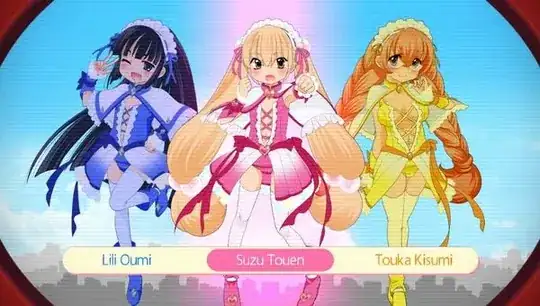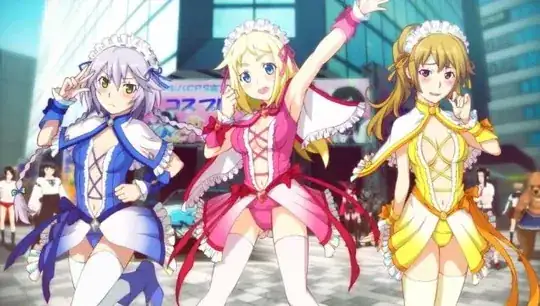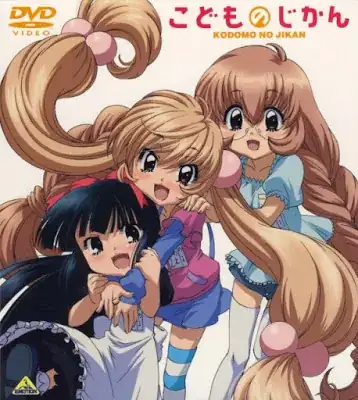「秋葉少女ストリッピスム」 (Akiba Shoujo Stripism) in Akiba's Trip: Undead & Undressed is not a parody of Pretty Cure specifically. Pretty Cure is a rather new franchise that started in 2004, which itself draws from mahou shoujo series dating from the 1990s.
Akiba Shoujo Stripism employs the characters from Kodomo no Jikan to blatantly parody the Pretty Rhythm franchise, as the three Stripism character's names are ピンクリズム (Pink Rhythm), ブルーリズム (Blue Rhythm), and イエローリズム (Yellow Rhythm). Pretty Rhythm's earliest incarnation, the Aurora Dream series in 2011, featured three girls in vibrantly-colored costumes; Pretty Rhythm is not mahou shoujo but rather is an idol competition series.
Akiba Shoujo Stripism also parodies the genre of mahou shoujo-mixed-with-sentai (live-action team fighting) which began in 1991 with Sailor Moon: this is clear because the characters are battling in the game, whereas Pretty Rhythm does not contain any fighting, and it looks like the characters attack using magic.
Akiba Shoujo Stripism is not a parody of the majority of mahou shoujo series. Before Bishoujo Senshi Sailor Moon, the long history of mahou shoujo series were usually EITHER one girl who could transform into a magical version of herself (Himitsu no Akko-chan, Mahou no Yousei Persia) OR one magical girl from another world who is temporarily living in our world and uses an Earthling disguise except for when she needs to transform into her true self to use her powers (Majokko Meg-chan, Mahoutsukai Sally, Mahou no Angel Sweet Mint). In both cases, she was not part of a group dressed in vibrantly-colored complimentary costumes. (Magical girls living solely in magical worlds, such as Kero Kero Chime or Akazukin ChaCha, do not technically fall within the genre of mahou shoujo because everyone in their world is magical; a mahou shoujo is a girl with magic powers in a generally non-magical world.) In some cases, a magical girl's identity allowed her to work as an idol (Mahou no Star Magical Emi, Mahou no Tenshi Creamy Mami, Cyber Idol Mink, Full Moon wo Sagashite), which drew mahou shoujo closer to the ordinary-girl-suddenly-becomes-an-idol sub-genre in shoujo (Idol Densetsu Eriko, Idol Tenshi Youkoso Youko, Chou Kuse ni Narisou and, of course, now Pretty Rhythm and its spin-off, PriPara).
Most of the occasions for which the pre-Sailor Moon magical girls transformed were for day-to-day events, NOT for battling or trying to save the world. At the same time, there was a long history of live-action sentai (team fighting) series, which created the group-dressed-in-vibrant-colors scheme (a famous example is Power Rangers which is adapted from Kyouryu Sentai Zyuranger). Sailor Moon was the first series ever to combine mahou shoujo with sentai: a colorful team of magical girls trying to save the world. Ensuing mahou shoujo-mixed-with-sentai series, such as Pretty Cure, Tokyo Mew Mew, Ai Tenshi Densetsu Wedding Peach, and Cutey Honey F, are rather obviously Sailor Moon-inspired (if not knock-offs).
Akiba Shoujo Stripism in Akiba's Trip: Undead & Undressed is a type of parody targeted at adult male viewers (whereas real mahou shoujo are a subset within shoujo, meaning they are targeted at an audience of young girls and if there is a manga origin or adaption, it runs in a shoujo manga magazine).
Puella Magi Madoka Magica is the currently well-known example of this strain of parody for adult males (which, unfortunately, gets referred to as being "mahou shoujo" proper, confusing people on what mahou shoujo is and isn't). Though Madoka Magica has clearly struck a chord for that demographic, it is not the first series-for-male-viewers to adapt the mahou shoujo genre. Cutie Honey was a successful men's version of the mahou shoujo genre (with a stripping theme), but it surprisingly ended up coming full circle by getting adapted into the actually shoujo series Cutie Honey Flash, which was marketed to girls. Project A-ko parodied mahou shoujo back in the 80s and there have been plenty of other shounen parodies since (Mahou Shoujo Pretty Sammy, Mahoutsukai Tai!, Mahou Shoujo Lyrical Nanoha, etc.).


